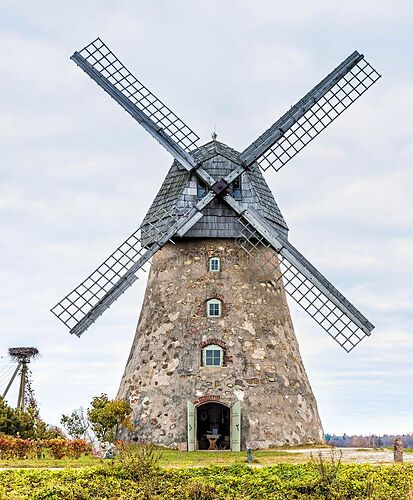We do have building:use=*, but even that doesn’t solve everything.
Windmills are installations to make use of windpower. This is covered by man_made=windwill.
They may come with or be constructed as a building which usually has a typical construction. This aspect is covered by building=windmill, even when the machine is out of order or has been removed.
Likewise, they may come with or be constructed as a tower.
Other constructions and housings are around, such as this tjasker mill.
Typical uses are pumping water, pumping gas, grinding and power production.
If the purpose is pumping gas or water, man_made=windpump would apply to the installation.
No single tag catches all cases. The mapper must make a decision what’s the most important aspect to map and tag in each particular case. That’s why I think deprecation of man_made=windmill is not a good idea.
That said, it’s always good to review cases, to see if the original mapping and tagging still fits the actual situation.
Are you sure that’s a windmill? Where’s the part that mills the grain?
Anyway, I’m not talking about some far-fetched cases for windmill. A windmill needs to have sails and be built to harness the wind power to grind cereals. I guess that’s pretty simple.
Something like this:
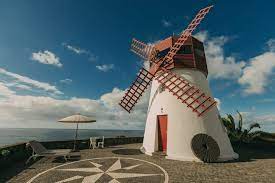
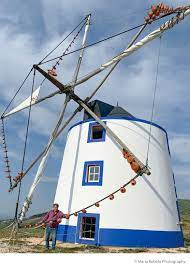

A windmill is different from a windpump and both have their own tags.
https://wiki.openstreetmap.org/wiki/Tag:man_made%3Dwindmill
https://wiki.openstreetmap.org/wiki/Tag:man_made%3Dwindpump
To be more accurate, windpump is special case of windmill (with own tags)
A windmill mills, a windpump pumps. That’s it.
About the function of the building (if it’s still in use), there’s always the chance of using this, which is widely used.
https://wiki.openstreetmap.org/wiki/Tag%3Acraft%3Dgrinding_mill
Traditional windmills in Nederland were/are used for pumping as well as milling grain and grinding spices. You can’t tell the difference from the housing, you would need to inspect the machinery. The many polders in Nederland were drained dry using windmills. I have never heard anyone use the word windpump for those mills.
The large turbines on high masts/towers for power are also called ‘windmolens’ (windmills). The word turbine in Nederland exists, but it does not include the masts, towers or housings.
Browsing around, I get the impression that we are not alone in this.
from Wikipedia header, included by forum software in your post:
from https://wiki.openstreetmap.org/wiki/Tag:man_made%3Dwindpump which you linked
also, given that such object was quite expensive to construct many were multipurpose
That’s probably a use that came later, to make use of the structure in such a peculiar terrain. Not many places in the world have buildings that do both things, I guess.
But in that case, if they do both things, they’re still windmills, although with more functions.
These are particular use types that could be properly refined with other tags, but the fact remains: a windmill is used to mill cereals (in some rare cases I know, also coal and stones), but all other uses and the extension of the word “windmill” don’t make them windmills, but a different structure that happens to have the same name.
In Portugal, for example, no one calls windmills to wind turbines. They’re are clearly different with different purposes.
The fulcrum here is “world the term has also been extended”.
I’m not discussing semantics here, I want to discuss the tag attributed to “buildings used to mill cereals with the help of wind”.
@AntMadeira I was actually convinced by you until I read the thread and realised the “diversity” of windmills. I guess my European perspective was a bit too narrow.
By now, I am sceptical as well (and honestly intimidated by the depth of the subject matter). Another day, another fact learned…
(Crazy that the US people thought at first of those weird skeleton things but I guess it makes sense)
Crazy is a strong word. I’ll say [not quite going so far as to use the word “admit,” as in "I’ll admit to being born in the 20th century in the American Midwest and seeing a lot of ‘skeleton’ (kinda funny word for them but I get it) windmills (and calling them exactly that, though the modern mammoth multi-megawatt ones are in my consciousness, too) to the point that that image is “classic” in my mind]. Though “Dutch style” is right up there, too.
These are regionalisms, localized concepts, people. Nothing really here to see, once we agree that differing peoples around the world (in a global project) are simply going to do this (we can’t help it). No need to be intimidated (though, it’s 100% understandable). A teachable moment; nice.
The word “windmill” in my brand of US English encompasses at least “skeletons” as well as “Dutch style” of the “things” we’ve seen graphics of here. The behemoths in large wind farms that grid-connect, I do hear those called “wind turbines” more often than “windmills,” though to my ear, the latter isn’t terribly incorrect, as the word “windmill” is encompassing of more that what grinds grains. It might grind grains, it might pump water or generate electricity delivered to the grid.
Now, let’s discuss “buildings used to mill cereals with the help of wind,” please.
You have said it. I think it should be best to separate the function of the man_made device from the building or other structure made to house and/or support this device, and it would be great to have a structured tagging for it. A simple approach would be:
If the device is made to mill some kind of grain:
man_made=windmill
if it is made to pump water or any other substance:
man_made=windpump
If the device is incorporated in a building, additionally:
building=windmill
if it is supported by a lattice tower:
no tag at the time being
If the building remains but the device is gone:
building=windmill without man_made=windmill/windpump
Problem:
-
man_made=windpump is acutally (according to the wiki page) exclusively used for those decoratively rusted and squeaky pumps supported by a lattice tower and common in rural arid areas around the world.
-
Windpumps incorporated in a building at the time being are usually tagged as
man_made=windmillorbuilding=windmill. -
There is no tag at the time being to specify if a windpump is supported by a lattice tower instead of a building.
-
The wikipage for
building=windmillas well asman_made=windmillare more or less the same and do not give a clue about the difference of these 2 tags.
So I’d say @AntMadeira is quite right with this issue - I would not support the deprecation of man_made=windmill but it would be well worth to refine the tagging scheme for these objects.
What is the purpose of the latice “blades”? Are they functional, decorative or the result of disuse?
The lattice blades usually are designed to be fitted with kind of sails made of fabric (same like ship sails). These sails were not permanently fixed but had to be adjusted according to the wind strenght. So this was a permanent task as long as the mills were operated and it was surely not an easy job to be done:
https://upload.wikimedia.org/wikipedia/commons/6/60/Molenaar_De_Helper.JPG
Of course there is no sail when the mill is no longer operated.
I certainly hope nobody is going to retag all our windmills. Adding windmill=windpump for the specimens that use the windmill power for pumping is fine with me. Category I’ll take your word for it.
I saw many different mills in Zaanse Schans. I liked the colour mill “De Kat” the best.
Fortunately, a sawmill is also a mill, even if I don’t understand what “sawing” has to do with “milling”. ![]()
But how to tag these two mills?
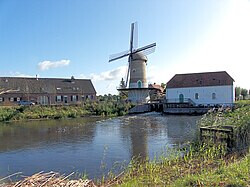
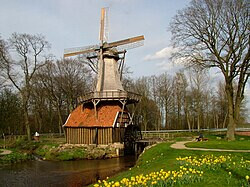
For those who don’t recognise it, these are wind water mills.
In german the term “Mühle” = “mill” is derived from “mahlen” = “grinding” meaning to crush something by a rotating movement and as such a “Windmühle” = “windmill” is understood predominantly as a device to grind something. Nevertheless the rotating power of windmills has also been used to drive water pumps or saw machines whereas the latter have been called “Sägemühle” = “sawmill”.
Not very much different from the english terms “mill” and “milling” which cover all kind of works done by rotating tools and as such windmills, saw mills, steel mills, textile mills, milling machines and the like.
Fortunately, a sawmill is also a mill, even if I don’t understand what “sawing” has to do with “milling”.
in English the term mill has a much wider meaning than in German, e.g. milling can mean “fräsen” (de)
From a dictionary: A building or group of buildings equipped with machinery for processing raw materials into finished or industrial products.
“a textile mill; a steel mill.”

